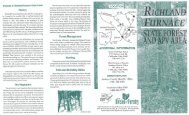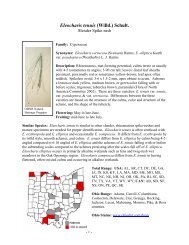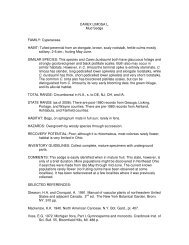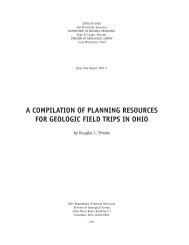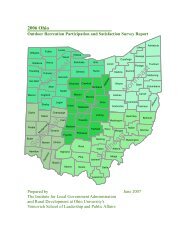Owls of Ohio - Ohio Department of Natural Resources
Owls of Ohio - Ohio Department of Natural Resources
Owls of Ohio - Ohio Department of Natural Resources
You also want an ePaper? Increase the reach of your titles
YUMPU automatically turns print PDFs into web optimized ePapers that Google loves.
C O M M O N O W L S O F O H I O 19D i e t b a rre d o w lBarred owls probably consume small mammals like mice and volesprimarily, but they will capture a diversity <strong>of</strong> small prey. Some studieshave shown high percentages <strong>of</strong> amphibians in their diet, and this makessense given their affinity for wet wooded habitats. It is likely that manybarred owls in <strong>Ohio</strong> shift to a diet heavy in amphibians during warmmonths, but this is hard to document as pellets composed mostly <strong>of</strong>amphibians rapidly disintegrate after being expelled. These owls alsotake small birds, reptiles, and even aquatic prey such as small fish. Theyhave been observed actively wading in shallow water attempting to seizefish or other aquatic animals.N e s ting barre d o w lMost barred owls use tree cavities as nest sites, <strong>of</strong>ten where brokenlimbs have created a recess within the tree. Occasionally, they will nestin abandoned stick nests built by American crows, red-tailed hawks, orother raptors. Barred owls typically lay their clutches <strong>of</strong> two or threeeggs in early to mid-March. The incubation period is about 30 days,and young hatch in April. The young birds leave the nest after four orfive weeks, but remain in the immediate vicinity. They are not capable<strong>of</strong> strong flight until three months or so <strong>of</strong> hatching, and it takes them sixmonths to fully molt into adult plumage.Vo c aliz ati o n s b a rre d o w lFew nighttime sounds are as loud and extravagant as a pair <strong>of</strong> barredowls in full song. Once they get going, a pair might keep up their repertoire<strong>of</strong> hoots, screams, chuckles and other odd sounds for half an hour or more.More than one camper has had their sleep disrupted by these noisy beasts.When two pairs engage in territorial squabbles, the sounds produced areenough to scare an uninitiated person out <strong>of</strong> the woods.The typical call is <strong>of</strong>ten described by the mnemonic Who Cooks For You,Who Cooks For You All. This song is unmistakable and <strong>of</strong>ten heard, and isused to announce territiories. A pair will <strong>of</strong>ten engage in duets with thisBarred owl on nest.This site is typical;a hollow formedwithin an older tree.Juvenile barred owl. Thisbird is probably fourto five weeks old andstill has many downyfledgling feathers. Youngowls leave the nest at thisstage and clamber aboutnearby branches untilthey can fly.Photos by: ODNR Division <strong>of</strong> Wildlife / Tim Daniel



